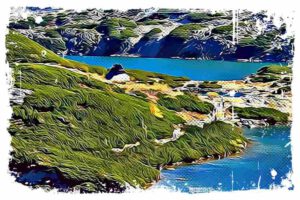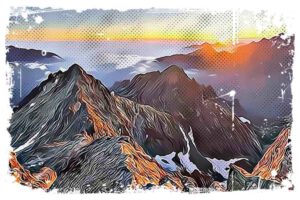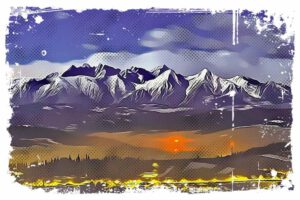Soaring at 2655 m above sea level, Gerlach stands as the mightiest peak of the Tatra Mountains and indeed, the entire Carpathians. Its regal stature earns it a place in the Crown of Europe, as the loftiest mountain in Slovakia.
But let me say, it’s not just about bagging another „best”. Hiking Gerlach, which is indeed what we’re talking about, is simply a joyous adventure offering breathtaking views as a bonus.
Do you dream of standing on the pinnacle of Gerlach, but feel like a novice in mountaineering? That’s perfectly fine. You don’t need to be an experienced climber, though it definitely wouldn’t hurt.
For a successful Gerlach ascent, you need to be fearless of exposure – that is, standing on the brink of the abyss. Even the easiest route to Gerlach’s top requires good physical condition. I believe these upcoming tips and advice will help bring your Gerlach dream closer to reality.
↳ Before you head to Tatra Park, I highly recommend reading my complete guide to Tatra Mountains. I showcase the most scenic places you won't want to miss. Make sure to check it out, so you don't overlook anything interesting: Tatra Mountains – An Insider’s Guide to All Attractions and Info
Gerlach Unveiled – Some Fascinating Facts
Before conquering a mountain, it’s worth getting to know it. And I’m not just talking about the climbing part. Here are some interesting tidbits about Gerlach:
- The peak’s name traces back to Gerlachov, a quaint village nestled at the foot of the High Tatras. Founded in 1326 by the four sons of a certain Gerlach, the village lends its name to the peak.
- Post World War II, in 1949, Gerlach was briefly renamed Stalin’s Peak. However, after the Soviet dictator’s demise, its traditional name was rightfully restored in 1959.
- En route to the climbing trailhead, we cross an intriguing spot known as Eternal Rain or Mokra Wanta. It’s a rock formation from which water persistently flows or drips, even in fair weather.
- A cable car ride almost became an alternative to hiking Gerlach. The interwar period saw plans for a cable car, but a shortage of funds led to its collapse.
- A tragic event occurred in 1944, when a Russian plane crashed on Gerlach’s slopes due to inclement weather and technical difficulties. The plane was carrying soldiers to support the Slovak uprising against Germany. Unfortunately, all 24 onboard perished. The scattered remains of the aircraft can still be spotted at various locations on Gerlach, intriguingly, on both sides of the mountain.
- The cross that graces Gerlach’s peak was initially erected in Rysy, in memory of a Slovak climber who succumbed to exhaustion and hypothermia in 1987. The cross was moved to Gerlach a decade later, in 1997.
Conquering Gerlach – What’s the Challenge?
Is hiking Gerlach a piece of cake? Well, not exactly. There are no marked trails to Gerlach, and the simplest route isn’t exactly a walk in the park. It’s a climbing expedition with difficulties rated I/II on the Tatra scale.
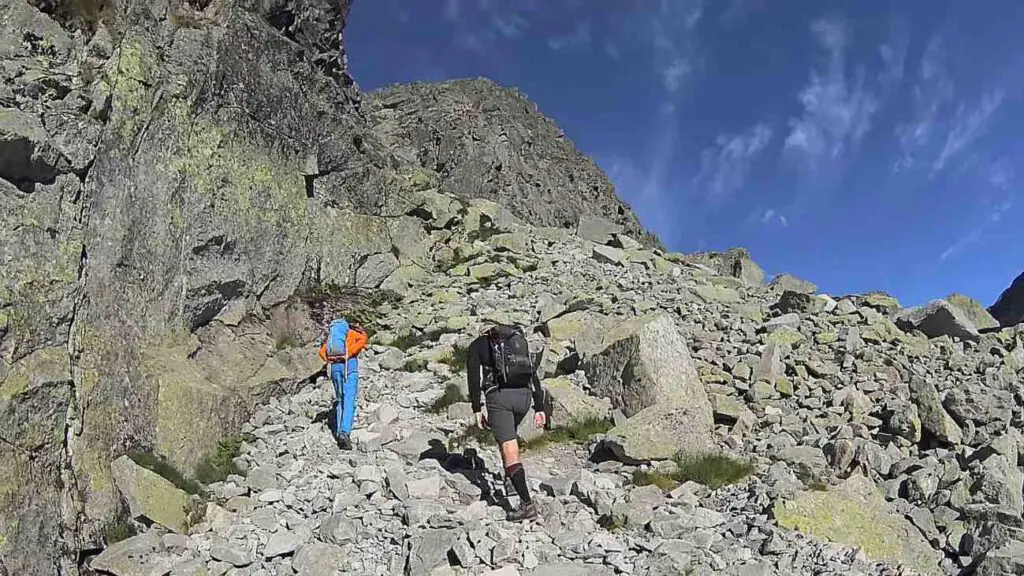
There’s no age restriction, but let me say, it’s generally not a kiddie adventure, mainly due to the need to use grips, buckles, or pull oneself up with chains. Fitness is a major factor—you don’t need to be a superhero, but be ready for a significant workout, especially when your knees protest during the descent.
Weather can significantly alter your climbing experience—everything’s peachy under a warm sun with dry rocks, but it’s a whole different ballgame when the rocks turn slippery, treacherous ice appears, or gale-force winds or storms surprise you.
The Easiest Route to Gerlach
Gerlach boasts many climbing routes, but the simplest and most popular one is through Wielicka Try, descending via Batyżowiecka Try.
This ascent and descent system, used primarily in the summer (not winter), follows an unwritten, yet commonly practiced rule of one-way traffic, which boosts safety by enabling faster team movement and reducing the risk of rockfall.
- I suggest you also read this article: Understanding the Risks – Tatra Mountains Death Statistics
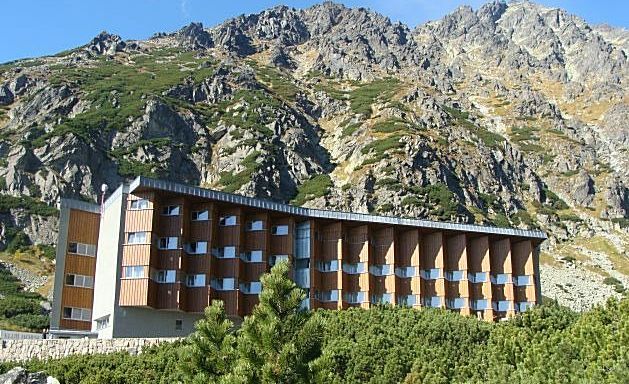
Typically, most Gerlach-bound adventurers start and end at Sliezsky Dom, a hostel perched at 1610 m. The total hike usually takes about 7-8 hours, with 4-5 hours for ascent and 3 hours for descent. Of course, factors like weather and the number of climbing teams (potentially causing „traffic jams”) can affect the timing
Where to Stay for a Hike in Gerlach?
To hike Gerlach, it’s best to stay in the hostel I mentioned above, Sliezsky Dom. This is the closest accommodation available for tourists. However, you need to know that it’s usually overcrowded, and there are often no available rooms or beds.
This generally means an average cost of about €110 for a standard double room, and in the „budget” option, €24 per person in a 12-person room (for this option, you need to bring your own sleeping bag and towel, and you can only stay for one night).
Unfortunately, during high season, booking a spot here is nearly impossible. However, there’s a broad range of accommodations available at the foot of the mountains where the average cost of private lodging is around €15 (the closer to the mountains, the higher the cost). Therefore, most tourists choose to stay in the town.
Below you can find all the best options in close proximity to the trail:
- (€) Sliezsky Dom: Sliezsky Dom is located in the heart of the Tatra Mountains, at an altitude of 1,670 meters above sea level. It offers elegant rooms with mountain views. For many it is preffered place to stay when hiking to Gerlach.
- ❤️ (€) Kurhotel Tivoli: This place is closest to the hiking trail, also it is a great place to stay anyway. It is restored historic building, dating back to 1902. It still retains its former charm and houses elegantly furnished rooms.
- (€) Danielov dom: The chalet offers free private parking, a shared kitchen and free WiFi. Towels and bed linen are provided in the cottage.
Best Time For Gerlach Adventure – When to Go?
While it’s technically possible to conquer Gerlach any time of the year, most hikers opt for the summer months (July-September). Winter and early spring bring the risk of avalanches, and summer can surprise you with thunderstorms. So, if you want to enjoy a relatively safe and comfortable climb, plan your Gerlach adventure for the summer.
You may also learn more about deadly thunderstorms on Giewont: Unbelievable Story Behind Giewont Peak’s Cross: Zakopane’s Tatra Icon
Gerlach – Guide Required
Due to the rules of the Tatra National Park (TANAP – Tatranský Národný Park), climbing Gerlach via the simplest route mandates a licensed guide. The only ones exempt from this rule are experienced mountaineers tackling more challenging routes, that is, those rated above III on the Tatra scale.
When it comes to guides, you can hire Polish guides (listed on the websites of the Polish Association of Mountaineering Guides or the Asociation of Mountaineering Tatra Guides) or Slovak ones, typically found around the office in Stary Smokovec.
It’s crucial to hire a guide with qualifications (like those from UIAGM/IVBV/IFMGA or a 1st or 2nd class Tatra guide and the European professional card EPC for Slovakia, which recognizes qualifications in that country). Avoid self-proclaimed, albeit cheaper, guides—they’re illegal, and using their services can lead to penalties and unpleasant situations. Plus, can you really trust such a guide?
Hiring a Guide for Gerlach – What’s the Price?
The average cost of hiring a guide for the „normal” route, i.e., via Wielicka Trial (other routes cost more), is around PLN 1,200 for Poles or EUR 320 for Slovaks, divided by the team size (three in summer, two in winter). If you hire a Polish guide, it’s worth clarifying who covers the guide’s travel costs from Poland to Slovakia and their entry to the Hostel.
Equipment For Gerlach – What to Bring
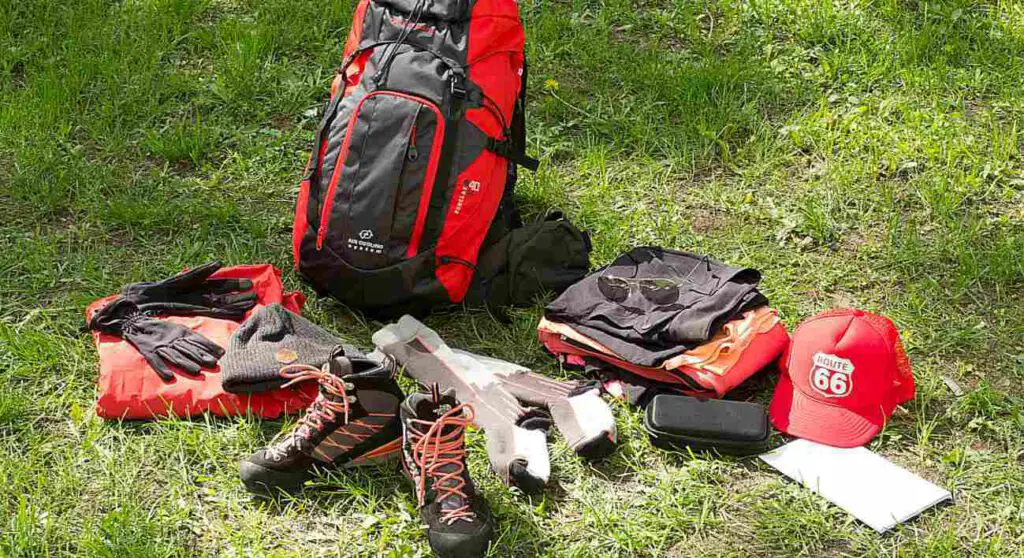
As for personal climbing gear, a helmet and a climbing harness are essential, and carabiners can be useful. If you don’t already have this equipment, your guide will likely provide it.
The guide will also have a safety line. Collapsible trekking poles can come in handy, and winter conditions necessitate crampons and an ice axe. Other essentials include a headlamp (even if you’re not planning a night trek, you might end up returning after dark), sunglasses, and clothing suitable for bad weather. Even in the heat of summer, it’s worth packing a warm hat and gloves.
Climbing shoes aren’t necesary—approach shoes are good for summer, but regular hiking shoes work too. In winter, you’ll need snow-appropriate footwear. And of course, don’t forget to pack enough liquids and energy snacks.
Logistics – How To Get To High Tatras
The closest border crossing to Gerlach is in Łysa Polana, though many travelers opt for the High Tatras via Jurgów. But since the cancellation of the minibus service between Zakopane and towns at the foot of the High Tatras, access for those without their own transportation has gotten a tad more complicated.
One option is to reach the city of Poprad (via buses or trains), where a cheap and frequent train known as the „elektricka” commutes to the High Tatras.
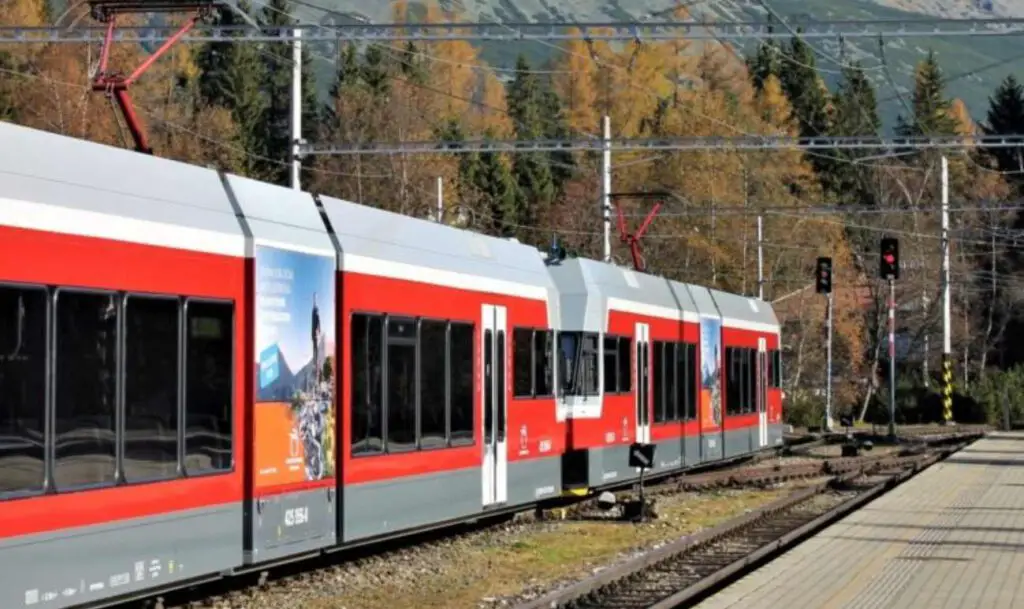
Getting from Tatrzańska Polanka to the Silesian House Hostel
Tatrzańska Polanka is a town nestled at the foot of the High Tatras, and it’s from here that the road to the Silesian House—a hostel that serves as a base for hiking Gerlach—begins. It’s a standard asphalt road, and when there’s no snow, any car can handle it. However, only cars with a special pass are allowed on it.
The usual practice is to park your car in Tatranska Polianka town and then either walk to the Silesian House along the green trail (5 km) or the asphalt road (7.2 km). Alternatively, the most popular choice is to use the transport provided by the guides and the hostel staff (€20 for a round trip).
The Ascent to Gerlach
The altitude difference between the Sliezsky Dom Hostel and the Gerlach Peak is 1045 meters. The hike typically starts early in the morning, often at dawn. Particularly when the weather forecast is good, guides aim to speed up the ascent to be the first ones on the trail if possible (minimizing the risk of traffic jams and falling rocks). By early afternoon, we’re generally back at the hostel.
Where to Eat?
There’s a restaurant in the Silesian House where you can order breakfast and dinner, or grab a bite and a drink after returning from the mountain. The closest shop is in Tatranska Polianka, situated at the base of the mountain. A wider variety of bars and restaurants can be found in Stary Smokovec or Tatranská Lomnica.
Make Sure You’re Insured Before Your Gerlach Expedition
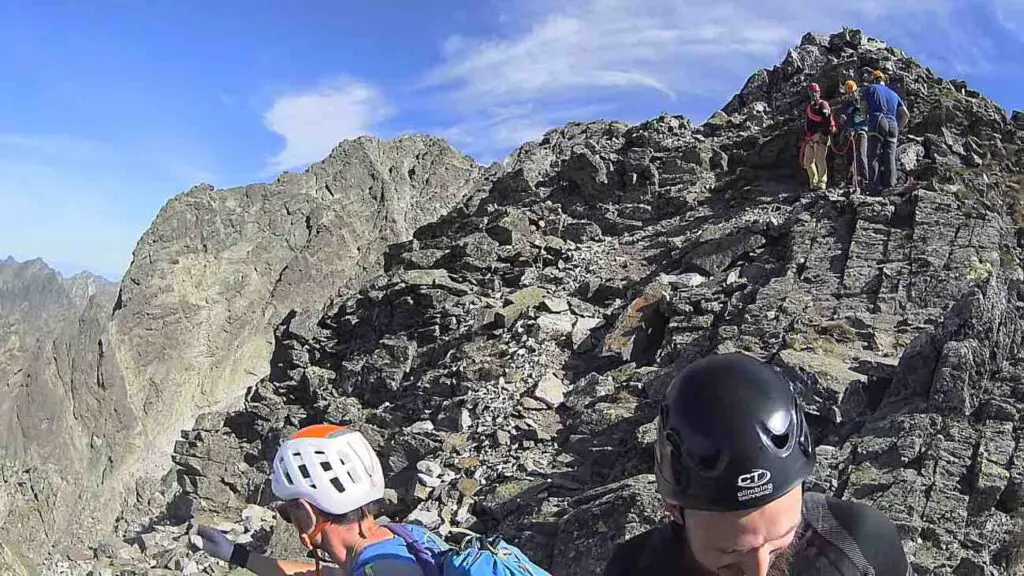
It goes without saying that when heading to the mountains, you should always have a charged mobile phone with the emergency number: 18 300 – the phone number for the Slovak Horska Serwis, the Slovak equivalent of TOPR (Tatra Volunteer Search and Rescue).
However, remember that rescue operations in Slovakia are not free, and it’s best not to assume that accidents only happen to others.
You must have insurance, and while it’s often included as part of the guide service, if you frequently visit the mountains (not just in Slovakia), it’s worth considering year-round mountain insurance.
If you’ve made it to the end of this text, it seems you’re set on reaching Gerlach’s summit. All that’s left for us to do is wish you a memorable photo with the distinctive cross adorned with a blue eyelet standing on Gerlach. We’re rooting for you – may the weather be in your favor, so you can admire the famed Tatra peaks during your climb.
Reaching The Top
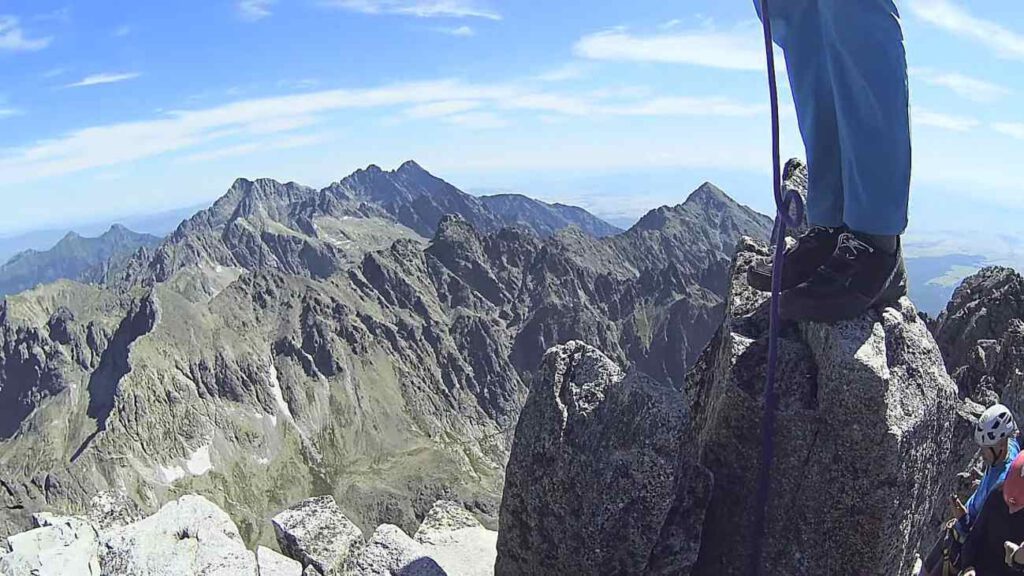
The panorama from Gerlach is truly breathtaking – you can see the curved Krywań, the inconspicuous from this perspective Rysy Peak, the twin-peaked Wysokie, the modest Staroleśny where Klimek Bachleda was among the first conquerors, a little further there’s Sławkowski, recognizable by its long slope, the massive Lodowy and Łomnica, decorated with the astronomical observatory building.
These views are a reward for your hard work. The second prize will be the satisfaction of having climbed Gerlach – the highest peak of the Tatra Mountains!
References:
- http://przewodnikwysokogorski.com/wyprawy/gerlach
- https://blog.decathlon.pl/sport/alpinizm/wejscie-na-gerlach-jak-sie-przygotowac/
- https://portaltatrzanski.pl/multimedia/filmy/wejscie-na-gerlach,1639

